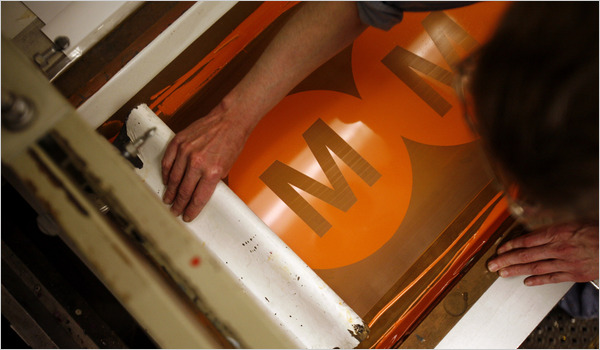 Crown Heights, NY – The signage of the New York City subway – stylish Helvetica, white-on-black type – is one of the most universally recognized design schemes in the world. By June 28, quite a bit of it will need to change.
Crown Heights, NY – The signage of the New York City subway – stylish Helvetica, white-on-black type – is one of the most universally recognized design schemes in the world. By June 28, quite a bit of it will need to change.
Subscribe to our Daily Roundup Email
On that Monday, disappearing trains (goodbye, W) and redrawn routes will render thousands of existing signs and maps throughout the system obsolete, a hidden cost of the drastic service cuts brought on by the subway’s budget problems.
To avoid chaos, New York City Transit must replace some 3,000 signs and 25,000 maps, all to be switched out within the span of about two weeks before the service changes take effect.
That task requires the biggest overhaul since service over the Manhattan Bridge was restored more than six years ago, juggling the Midtown subway routes.
John Montemarano, director of the station signage division for 15 years, said: “We make sure our customers can wake up on June 28 and figure out how the hell to get around.”
The replacements range in size and price. A small vinyl M decal, newly orange, may cost the agency about $25 to produce. A giant porcelain sign, like “42 St – Times Square,” costs about $300 to make.
All told, the cost of the new signs and maps is expected to reach about $800,000. Some of that money was already budgeted, the agency said, since new maps are printed every year.
All traces of the V and W trains, two of this year’s casualties, must be struck from the system, while decals for the rerouted M line – it will head north on Avenue of the Americas in Manhattan, replacing the V – must be added to signs and entrances at dozens of stations.
Even more minor changes require dozens of replacements. The Q line, for instance, will now terminate in Queens, not Midtown Manhattan, which means every station along its route must advertise “Q to Astoria” rather than the current “57 St – 7 Av.”
At the subway’s sign shop, in Crown Heights, Brooklyn, word went out a while ago: no vacations in May and June.
“We’re going to be swamped,” said Kris Curtis, one of the dozen or so workers who produce up to 200,000 aluminum and porcelain signs a year.
A phalanx of maintenance workers is poised to fan out across the system – ladders and fresh signs in tow – on a single whirlwind weekend before June 28, the Monday morning when most of the bus and subway cuts will take effect.
The idea is to minimize confusion and allow breathing room for any last-minute revisions: In 2009, the entire service-cut package was avoided by an 11th-hour Albany bailout.
Some of the changes will start as slapdash: The circular logos for the V train – known in-house as bullets – will get an M decal taped over for now, and will later be replaced with a permanent sticker.
A small station may need fewer than a dozen signs replaced; a major transfer point, West Fourth Street, which will now be a stop for the M instead of the V, requires 147 new signs.
But don’t expect new signs at big stations like Herald Square or Rockefeller Center until just a few hours before the changes.
“Anything in Manhattan, we try to wait until the last minute,” Mr. Montemarano said.
The subway’s sign shop, in a nondescript shed near Utica Avenue, is a cross between high school shop class and a SoHo art studio. Cool jazz hummed from a radio on a recent visit, and a bag from City Lights, San Francisco’s beatnik bookstore, hung from a wall over a stack of back issues of Art in America magazine and vintage catalogs from Christie’s, the auction house.
Most of the dozen or so workers have training in advertising or graphic design; a few are graduates of the Pratt Institute, the Brooklyn university known for its arts curriculum.
It takes about two months to produce a porcelain sign, so transit officials are ordering up temporary aluminum replacements for the first few months. A few early prototypes have already been produced, including the first orange M decals and a message never seen before in the system: “M to Forest Hills-71 Av via 6 Avenue.”
Old signs will be donated to the city’s transit archives or sold online, although officials said any revenue would be negligible.
To create the signs, designers use old-fashioned tools like rulers, X-Acto knives, vinyl prints and silkscreen machines: “It’s just like making T-shirts,” Mr. Montemarano said.
For their part, the workers say New York City Transit represents somewhat of a holy grail of public sign producers. “You don’t pass up a job like this,” Marc Lussier, a two-year veteran, said.
The subway map will also need to be updated for the changes. More than 7,000 maps on buses will be changed, and 1,800 of the billboard-size maps that stand upright on platforms will get changed out. Those will cost the authority about $180,000.

At least this money is going for a (sort of) good purpose, as opposed to the thousands (may have been millions, I forgot) that the supposedly cash-strapped MTA spent on changing the Triboro Bridge signs.
another waste of money
i want that contract
Will the Williamsburg M train go to 6th ave in Manhattan?